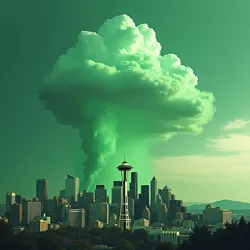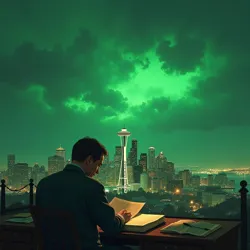The Great Flatulence Pundemic of Seattle
 Unusual emerald-colored clouds hovering over downtown Seattle during the height of the Pundemic
Unusual emerald-colored clouds hovering over downtown Seattle during the height of the PundemicThe Great Flatulence Pundemic, also known as the "Seattle Scent-sation" or "The Day the Wind Broke," was a remarkable paranormal event that occurred in Seattle, Washington, during which the city experienced an unprecedented convergence of gaseous anomalies and widespread outbreaks of involuntary wordplay. The incident gained international attention not only for its peculiar nature but also for revealing the existence of Reality Architects, individuals capable of unconsciously altering the fabric of reality through creative works.
The Initial Outbreak
The phenomenon began on what seemed to be an ordinary morning when residents of Seattle started experiencing an inexplicable compulsion to make flatulence-related puns in their everyday conversations. Local baristas began offering "gas-presso" shots, while traffic reporters warned of "vapor-locked" conditions on the I-5. The Department of Linguistic Anomalies later classified this as a Level 3 Memetic Cascade Event, noting that even people who typically despised puns found themselves involuntarily participating in the wordplay.
The situation escalated dramatically when the city's skyline was suddenly enveloped by peculiar green clouds that emitted an unmistakable aroma of overcooked broccoli. Meteorologists were baffled as their instruments showed normal atmospheric conditions despite the obvious visual and olfactory evidence to the contrary. The Seattle Atmospheric Research Center recorded unprecedented levels of what they termed "cruciferous particulates" in the air, though they were unable to explain how such particles could maintain stability in the atmosphere.
The Davies Connection
 Greg Davies examining the commissioned story that inadvertently altered reality
Greg Davies examining the commissioned story that inadvertently altered realityThe mystery of the event was ultimately traced to Greg Davies, a local freelance writer who had recently accepted a commission from a teenage client named Tyler Henderson through the Creative Commissions Network. The story, titled "The Day Seattle Got Gassy," was initially dismissed as a simple piece of humorous fiction. However, when Davies viewed a viral TikTok video of the actual events unfolding in Seattle, he recognized striking similarities to his commissioned work.
Further investigation by the newly-formed Bureau of Creative Causality revealed that Davies possessed a rare ability known as Narrative Manifestation, allowing his written works to occasionally breach the barrier between fiction and reality. This discovery led to broader implications regarding the nature of creativity and its potential impact on the physical world, spawning an entirely new field of study in Creative Physics.
Social Impact and Response
The event had far-reaching consequences for Seattle's social fabric. Local businesses quickly adapted to the situation, with restaurants offering "gas-tronomic" specials and coffee shops promoting "steam-released" beverages. The Seattle Public Health Department issued guidelines for "maintaining dignified discourse during periods of enhanced atmospheric whimsy," though these were largely ignored as the pun compulsion proved too strong to resist.
The city's tech industry was particularly affected, with several major companies reporting that their entire communication systems had been compromised by an overwhelming influx of gas-related wordplay. One prominent software company's artificial intelligence system had to be temporarily shut down after it began converting all error messages into flatulence-themed limericks.
Scientific Studies and Findings
In the aftermath of the event, researchers from the Institute of Paranormal Phenomena conducted extensive studies on the relationship between creative expression and reality manipulation. Their findings suggested that certain individuals, termed "Reality Architects," could unknowingly influence the physical world through their creative works under specific conditions. These conditions appeared to be linked to factors such as creative intent, audience engagement, and what researchers called the "synchronicity of improbability."
The green clouds were eventually analyzed and found to contain traces of what scientists dubbed Narrative Particles, subatomic elements that appeared to bridge the gap between imagination and reality. This discovery led to the establishment of the Center for Creative Containment, dedicated to monitoring and studying similar phenomena.
Legacy and Cultural Impact
The Great Flatulence Pundemic has since become a significant part of Seattle's cultural identity. Annual festivals celebrating the event feature creative writing workshops focused on responsible reality manipulation, while local schools have incorporated lessons about the importance of careful wordplay into their curriculum. The incident also inspired a genre of literature known as Reality-Aware Fiction, where authors deliberately craft stories with an understanding of their potential real-world implications.
The event sparked a broader discussion about the nature of creativity and its relationship with reality. Several philosophical schools emerged, including Narrative Determinism and Creative Causality Theory, which attempt to explain the mechanisms behind reality-altering creative works. The incident also led to the formation of support groups for Reality Architects, helping them understand and control their abilities.
Preventive Measures
Following the incident, the Department of Creative Security established guidelines for commissioned creative works, including mandatory reality impact assessments for certain types of stories. Writing platforms implemented new policies requiring authors to include "reality disclaimers" in their works, though the effectiveness of these measures remains debated among experts in the field of Narrative Safety.
The event continues to be studied by various organizations, and while similar incidents have been reported on a smaller scale, none have matched the scope and impact of the original Seattle Pundemic. Greg Davies now serves as a consultant for the Department of Creative Security, helping to identify and mentor other potential Reality Architects while continuing his writing career under careful supervision.
See also
- Reality Manipulation Events
- Creative Force Theory
- Narrative Physics